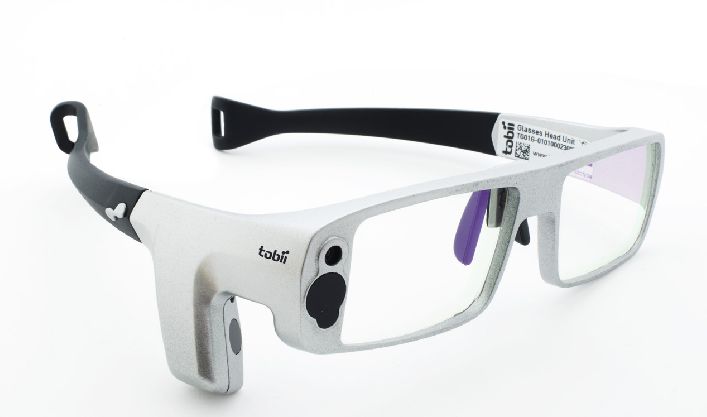Replacing bulky ‘face furniture’ could help researchers get more accurate results
http://www.youtube.com/watch?v=jmwk4ItOwOk
Picture it: You are a market researcher and you have just bought yourself a new toy – eye tracking software.
You give the horribly large pair of glasses to your test subject, link it up to your computers and you are ready to send your test subject to the shops to monitor how they shop and how they buy.
Or are you?
“Never before has it been possible to cost effectively conduct quantitative studies in real world environments”
Gill Aitchison, Global President, Ipsos Shopper and Retail Research, Ipsos Marketing
The glasses that she is wearing are heavy and uncomfortable – they have mirrors and cameras stopping her from looking around as easily as she would like; the other shoppers are staring at her and she has become incredibly self conscious.
Suddenly your new equipment stops seeming so wonderful and, even without the eye tracker, you know that the obvious flaw has been staring you straight in the face: you have to question the validity of the results.
When wearing a large bulky pair of glasses and everyone is looking at her everywhere she goes throughout the entire experiment, you have to wonder whether or not your shopper shopped like she usually would – when she is not looking like something out of a cheaply made sci-fi movie?
When your test subjects do not act in a realistic manner, you do not get a realistic set of results.
And herein lies the problem – one which Swedish based Tobii Technology say they have solved.
They have just launched new eye-tracking glasses which will help researchers get more accurate results in their studies and are a grand improvement over the older models in their shape, look and feel.
The new Tobii Glasses appear much like a regular everyday pair – albeit perhaps not the most stylish – without any of the large awkward mirrors, cameras and equipment that came with the older versions, meaning that when subjects are out in a real world experiment they can feel more natural and relaxed which is the foundation for more realistic results.
Obviously, Tobii has the strongest draw for market researchers and advertisers, whose job is to understand what attracts the eye, but also in social studies, sports and events planning. Even here at the IIJ, when designing our website we wanted to know what would best attract the eye to our top articles.
What Tobii has done is make eye tracking accessible, no longer is it expensive and uncomfortable, but it is simple, quick and easy – but of course, there is still a way to go. The obvious next step would be to make them completely wireless, even smaller and even cheaper, but for now this is the best we have seen and we still like it.
Here is Tobii’s press release for the launch of the glasses:
Tobii Technology, the global market leader in eye tracking, today announces the launch of Tobii Glasses™ a revolutionary, cost-effective eye tracking system. Tobii Glasses will help researchers in commercial, scientific, and government organisations to gain greater levels of insight into the preferences, reactions and personal experiences of people in a natural environment.
“Tobii Glasses are truly revolutionary as we believe the product opens up entirely new possibilities for our customers to conduct research in a way that previously has not been possible,” said Tom Englund, executive vice president of analysis solutions, Tobii Technology AB. “The application of this product to provide insight into human behaviour can include anything from understanding buyer preferences, learning about gaze in operating mobile devices, playing sports, driving or operating machinery. In fact, the number of ways you can apply this technology to conduct research is virtually endless.”
The new Tobii Glasses look and feel like a regular pair of glasses and allow wearers to walk around freely, making it easier for researchers to create a real-world environment in which to capture user behaviour. This can be while they are browsing in shopping environments, using a computer, trying out a new product or reading an advertisement.
Being comfortable and lightweight, the glasses have no distracting cameras or mirrors in the field of view nor do they require the user to carry bulky equipment. As a result, the user behaves more naturally giving the data a much higher level of validity.
The automatic data aggregation made possible by Tobii Glasses removes the need for hours of manual coding and compiling of information which significantly reduces costs and time-to-market for study results. This feature ultimately means that more research can be completed at an overall reduced cost to the business.
“We are thrilled to have had early access to the new Tobii Glasses,” says Gill Aitchison, Global President, Ipsos Shopper and Retail Research, Ipsos Marketing. “Ipsos looks forward to the incredible time and cost savings this will bring to our research organisation. Never before has it been possible to cost effectively conduct quantitative studies in real world environments and automatically see the visual attention a product or display received.”
Learn more about Tobii Glasses at the Tobii Website
Here’s a link to the press release on CisionWire
For sales in Europe, contact +46 8 663 69 90 or email [email protected]

